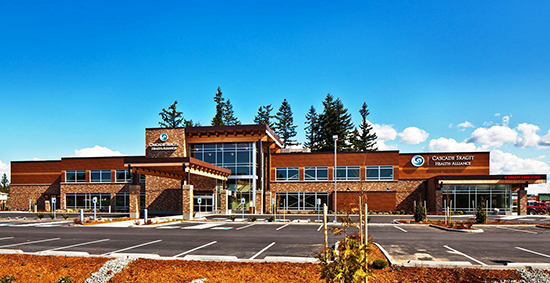|
Subscribe / Renew |
|
|
Contact Us |
|
| ► Subscribe to our Free Weekly Newsletter | |
| home | Welcome, sign in or click here to subscribe. | login |
Construction
| |
 |
May 2, 2013
Health Care
Cascade Skagit Health Alliance
Synergy Construction
Architect: Botesch, Nash & Hall
Engineer: DCI Engineers
Owner: Smokey Point Medical
ABC members: Propel Insurance; Safety Matters; Schmitz & Associates
The long-time collaboration between Skagit Valley Hospital in Mount Vernon and Cascade Valley Hospital and Clinics in Arlington is now set in stone, literally, with the opening of the Cascade Skagit Health Alliance multi-specialty medical facility on five acres in Arlington.
Synergy Construction was hired as general contractor for this complex 42,000-square-foot project. Early on, the company knew that creating a team-oriented subcontractor base would be critical. Every single piece of the building had to be pre-planned with input from all involved trade partners. There are so many hidden elements in the construction of such a sophisticated medical complex like this that success would not have been possible without extensive planning sessions and hundreds of hours of coordination with the team.
In-house coordination with 3-D shop drawings were key to the success of the project. The design consisted of two levels of steel structure with concrete pan decking. The exterior cladding had a full rain screen system, brick veneer, Trespa panels and a complicated glazing system with full curtain walls in front. The function of the facility required state-of-the-art mechanical, plumbing and electrical systems that would be highly integrated and work seamlessly together.
One of the biggest challenges during this project involved the construction of the MRI department. The MRI machine had been ordered from the German manufacturer Siemens prior to the start of construction, even before the general contractor was selected. Siemens specified a date for delivery of the machine that could not be changed for, as soon as the MRI machines come out of the factory, they are put on a 747 with only enough liquid helium to keep them cool for 10 days. So the room had to be ready and the team had to be prepared to install this delicate and sophisticated machine the day after Christmas.
The finished medical building has 58 examination rooms and four procedure rooms for primary care, 10 examination rooms and two procedure rooms for urgent care, the MRI and digital X-ray, and full lab services.
The project covered 10 months and 6,229 worker hours without any time-loss injuries.
Other Stories:
- Safety's role in the ‘new normal’ of construction
- Electrical & Communications
- Commercial Construction
- Survey: Andersen Construction
- Demolition
- Specialty Construction (merit award)
- Survey: S.D. Deacon
- Survey: Lease Crutcher Lewis
- Survey: Skanska USA
- Survey: Express Construction Co.
- Survey: PCL Construction Services
- Mechanical Construction
- Mixed-Use Construction
- Institutional
- ‘Big Room’ streamlines collaboration, communication
- Technology moves construction projects off the paper trail
- Going modular? Think of the factory as a big subcontractor
- Sharp equipment managers use decision points
- Sick leave, pot laws leave employers feeling queasy
- Making sense of construction cost audits
- Is your insurance broker a claims advocate?
- Avoid the pitfalls of transition planning
- Eagle of Excellence Award • Tenant Improvement/Renovation
- Eagle of Merit Award • Specialty Construction
- Survey: Rider Levett Bucknall



